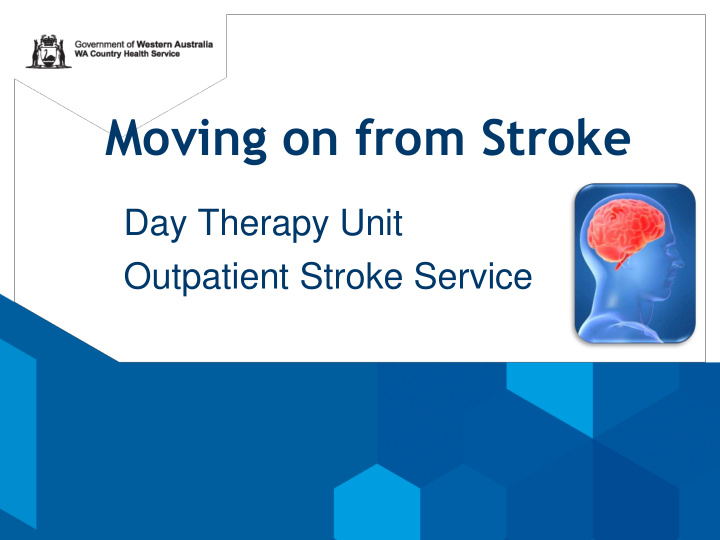



Moving on from Stroke Day Therapy Unit Outpatient Stroke Service
WELCOME! Week 1: What is a Stroke? What is a TIA? The signs The risk factors Nutrition for stroke Label reading
Week 2: Pharmacy; Medications Physiotherapy; Exercise Recommendations Speech Pathology; Communication Neurological Council of WA Week 3: Occupational Therapy; Driving and Fatigue Social Work; Mood and Emotional Support Dietitian; Australian Guide to Healthy Eating
Statistics Every 10 minutes, an Australian will have a stroke. 1 in 6 Australians are affected by stroke. In Australia stroke kills more women than breast cancer and more men than prostate cancer. Stroke events are likely to increase in the future. Good news: more people are surviving a stroke than previously and disability caused by stroke is improving.
WHAT IS A STROKE?
A TRANSIENT ISCHAEMIC ATTACK (TIA) “Mini - stroke” Same symptoms as a stroke but they will go away within 24 hours Always seek medical attention immediately if you have any signs of stroke
WHAT ARE THE SIGNS OF STROKE / TIA? Weakness or numbness The signs of stroke Difficulty speaking may occur alone or in or understanding combination. Dizziness, loss of Any signs require balance medical attention. Loss of vision Headaches Difficulty swallowing
Stroke is ALWAYS a medical emergency.
Effects of a Stroke
RISK FACTORS FOR STROKE Uncontrollable Controllable Age Smoking Gender High blood pressure Previous stroke/TIA High cholesterol Family history heart disease Poor diet Personal history of heart disease Excess weight Alcohol and/or other drug consumption Low activity levels Stress Diabetes
WHAT IS YOUR STROKE RISK?
REDUCING YOUR RISK OF STROKE Know your personal risk factors: high blood pressure, diabetes and high cholesterol (know your numbers!) Be physically active and exercise regularly Maintain a healthy body weight by following a healthy diet Limit alcohol consumption Avoid cigarette smoke. If you smoke, seek help to stop. Learn to recognise the warning signs of a stroke and act FAST
Smoking Cessation Smoking increases blood pressure and the risk of blood clots forming GP or Community Pharmacist QUITLINE - 13 78 48 (13QUIT) Visit www.quitnow.gov.au QuitCoach online service
Lower Your Blood Pressure Normal BP is 120/80 – Do you know yours? Lower salt intake by: Choosing low salt products with <120mg sodium per 100g Do not add salt to food in cooking or at the table Choose less convenience foods Flavour foods with spices and herbs instead of salt Avoid high salt foods – what are they?
High Salt Foods – to LIMIT:
Lower Salt Choices:
Lower Your Cholesterol LDL cholesterol (“bad” cholesterol) builds up on the arteries HDL cholesterol (“good” cholesterol) removes the cholesterol and sends to the liver for processing
Saturated fats increase LDL “bad” cholesterol and increase stroke risk: Fatty and processed meats Full cream dairy Most takeaway foods
How to lower your saturated fat intake: Choose lean meats Trim visible fat off meat and skin off chicken before cooking Limit processed meats e.g. sausages, salami, bacon Choose low fat dairy products Use low fat cooking methods; grilling, baking, steaming Avoid frying food or cooking with butter/cream Limit takeaway meals and processed foods Choose healthier snacks; unsalted nuts, fruit
Monounsaturated and polyunsaturated fats increase HDL “good” cholesterol and lower LDL “bad” cholesterol: Margarine spreads Monounsaturated and polyunsaturated oils e.g. canola, olive, peanut, sunflower, safflower, soybean Nuts e.g. cashews, peanuts, almonds, walnuts, hazelnuts, brazil nuts Avocado Fish
Be a Healthy Body Weight What can we do to ensure we are a healthy weight? Being overweight or obese can contribute to: High blood pressure High cholesterol Lead to type 2 diabetes and heart disease Refer to a dietitian for individualised advice
When trying to achieve a healthy weight, aim for: Moderation and Variety 1.Gradual weight loss of 1-4kg per month 2. Regular meals to avoid overeating; 3 main meals or smaller, more frequent meals
3. High-fibre breads and cereals, fruit and vegetables 4. 6-8 glasses water daily to assist with hunger 5. Eat less fat, especially saturated fat 6. Alcohol in moderation
Alcohol in Moderation Recommendations: no more than two standard alcoholic drinks per day, with two alcohol-free days per week
Be Active Think of movement as an opportunity, not an inconvenience Be active every day in as many ways as you can e.g. gardening, housework Recommendations: put together at least 30 minutes of moderate-intensity physical activity on most, preferably all days.
How to Choose Healthy Products Ingredients list Nutrition information panel Nutrition claims ‘Use by’ date Nutrition symbols
Ingredient’s List Listed in order by weight from the largest to the smallest
Nutrition Claims Products contain less than 3g per 100g Low fat/low salt Products contain 25% less fat Reduced than the original product fat/reduced salt May be describing taste, texture, Lite/light colour No added sugar No sugars have been added however it may be high in natural Cholesterol free sugars Diet Does not mean low fat Usually means artificially sweetened
NUTRITION TIP OF THE WEEK Slow and steady wins the race. Make small diet and exercise changes gradually over time for your best chance of sustained weight loss. Thankyou for attending! See you next week!
Recommend
More recommend